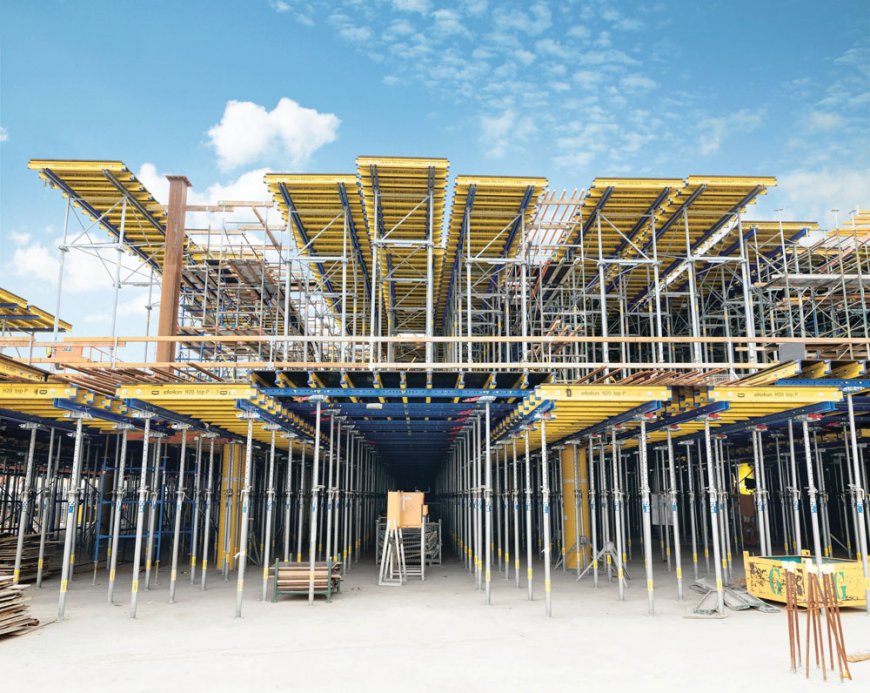On continuous innovation

The scaffolding and formwork solutions are transforming to effectively tackle the ever-growing demands of technology needs in an economical way. Construction Times explores the trend.
Scaffolding and formworks are important means used in the buildings and infrastructure construction activities. Scaffolding is used around the buildings and structures to work at height. In simple terms formworks are molds that cast concrete in various shapes and sizes. They used to construct concrete columns, beams, slabs and similar structures. The use of scaffolding and formwork is growing with construction activities picking up.
Scaffolding market scenario
Since time immemorial, scaffolding has been an essential part of construction projects world over. They are typically used to get access to structural components at an elevation but also serve many other purposes in construction. Over the years, scaffolding has been upgraded with the transforming requirements of the construction industry. Different types of scaffolding have been used to support workers and their tools and in situations where they are used to support considerable loads from materials such as bricks, concrete, blocks, etc.
Depending on the applications, various types of scaffolding are being used in construction projects. These include brick layer scaffolding, mason’s scaffolding, tubular scaffolding, needle scaffolding, modular scaffolding, etc.
Formwork market
Commonly known as shuttering in the construction industry, formwork is an essential part of the construction industry that can be considered to be indispensable for any kind of construction project, small or large. Formwork is currently available in different materials which include timber, plywood, steel, aluminium and plastic.

The construction industry is witnessing a shift towards modular formwork systems made from advanced materials like plastic. According to Vikas Kumar Mittal, Director, Nova Formworks, these systems are lightweight, durable, and easier to handle compared to traditional timber or steel options. “This translates to faster assembly and disassembly, reducing labour costs and project timelines. Additionally, advancements in concrete technology, like self-compacting concrete, are driving the need for formwork systems that adapt to these new materials and optimize concrete placement,” he adds.
Demand trend
The scaffolding and formwork market in India is experiencing a surge in demand, driven by a confluence of factors. Firstly, the government's ambitious infrastructure projects across sectors like transportation and energy are creating significant opportunities. Secondly, there's a growing focus on high-rise construction in major cities, requiring sophisticated formwork solutions.
With all that being said, it’s important to emphasise that customer needs are evolving. Today, contractors are seeking not just equipment, but complete solutions. They prioritise safety, efficiency, and faster project completion times.
According to Mittal, the demand for scaffolding and formwork is expected to rise due to increasing infrastructure development and growth in the construction sector. Customer needs are evolving towards cost-effective, lightweight, and user-friendly formwork solutions that promote safety and efficiency.
Innovative solutions
With projects becoming bigger and complex, new innovations are beings adopted by the players in scaffolding and formwork market. Advancements are happening in both design and materials for scaffolding and formwork. According to Mittal, modular systems with interchangeable components are gaining popularity for their versatility and ease of use. Lightweight materials like aluminium and high-strength plastics are being increasingly used to improve worker safety and maneuverability.
Nova Formworks offers a range of innovative plastic formwork solutions, including wall, column, and slab formwork systems. Mittal adds, “Our products are designed for ease of use, durability, and reusability. They are lightweight and can be assembled with minimal labour, contributing to faster construction cycles and reduced costs. For challenging projects, Nova Formworks offers custom solutions and on-site technical support to ensure successful formwork implementation.”
As a major player in the global market place, Doka offers innovative formwork solutions that are designed to be the cornerstone of economical project delivery. Doka formwork boasts exceptional reusability. Systems are engineered with durability in mind, lasting for multiple projects. This reusability significantly reduces waste and translates to cost savings compared to traditional formwork that's often discarded after a single, or only a few uses.
Doka India is constantly innovating to provide its construction partners with the best possible formwork solutions. Doka’s forte is however, tackling some of the world’s most challenging projects, a good example being its work on the Dwarka Bridge. Here, Doka formwork and engineering solutions have successfully been used to deliver a 900-metre central cable-stayed bridge, including highway approaches. Spanning a length of 2.5 km, the 29.6-metre-wide, four-lane bridge includes 3.5 km of retaining walls, and a 1.42-km approach on either side. Comprised a composite deck and pylon structure, the total length between the two pylons stretches 500 metres, making it the largest span of any cable stay bridge in India.
Market outlook
The Indian infrastructure sector is poised for significant growth, driven by government initiatives like Smart Cities Mission and National Infrastructure Pipeline. This translates to a positive outlook for Doka India, which sees a rise in demand for both, formwork, and scaffolding. However, cost pressures remain a challenge throughout the industry. As a result, Doka is addressing this by optimising its product portfolio to offer cost-effective solutions without compromising on safety.
Mittal is of the view that the scaffolding and formwork market is expected to witness significant growth driven by factors like increasing urbanization, infrastructure development, and a growing focus on safety and efficiency in construction. Rising urbanization and infrastructure development will generate increased demand for residential and commercial buildings, bridges, and other structures, all of which rely on scaffolding and formwork for construction. The growing adoption of prefabricated construction methods, which depend heavily on efficient formwork systems for quick and precise concrete shaping, will further propel market expansion. Also, a growing focus on sustainability is boosting the popularity of reusable plastic formwork solutions due to their lower environmental impact compared to traditional methods. “This shift in preference will drive significant market growth for these sustainable products. In conclusion, with innovation, safety, and sustainability at the forefront, the scaffolding and formwork market is poised for significant advancements in the years to come,” Mittal concludes on a positive note.







